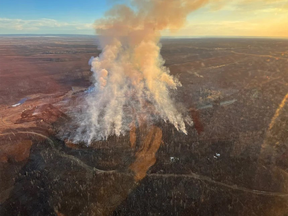Steve Bull's Blog, page 49
April 25, 2024
Divide and Conquer: The Government’s Propaganda of Fear and Fake News
“It is the function of mass agitation to exploit all the grievances, hopes, aspirations, prejudices, fears, and ideals of all the special groups that make up our society, social, religious, economic, racial, political. Stir them up. Set one against the other. Divide and conquer. That’s the way to soften up a democracy.”― J. Edgar Hoover, Masters of Deceit
“Nothing is real,” observed John Lennon, and that’s especially true of politics.
Much like the fabricated universe in Peter Weir’s 1998 film The Truman Show, in which a man’s life is the basis for an elaborately staged television show aimed at selling products and procuring ratings, the political scene in the United States has devolved over the years into a carefully calibrated exercise in how to manipulate, polarize, propagandize and control a population.
Take the media circus that is the Donald Trump hush money trial, which panders to the public’s voracious appetite for titillating, soap opera drama, keeping the citizenry distracted, diverted and divided.
This is the magic of the reality TV programming that passes for politics today.
Everything becomes entertainment fodder.
As long as we are distracted, entertained, occasionally outraged, always polarized but largely uninvolved and content to remain in the viewer’s seat, we’ll never manage to present a unified front against tyranny (or government corruption and ineptitude) in any form.
Studies suggest that the more reality TV people watch—and I would posit that it’s all reality TV, entertainment news included—the more difficult it becomes to distinguish between what is real and what is carefully crafted farce.
“We the people” are watching a lot of TV.
…click on the above link to read the rest of the article…
South Koreans sue government over climate change, saying policy violates human rights

Plaintiffs, lawyers and activists gather outside South Korea’s constitutional court in Seoul ahead of a public hearing for a climate lawsuit on Tuesday, April 23, 2024.
SEOUL — As plaintiffs, lawyers and activists chanted slogans outside South Korea’s constitutional court on Tuesday, 17-month-old Woodpecker giggled, sending ripples of laughter through the crowd.
Woodpecker is the nickname of Choi Heewoo, the youngest among more than 250 plaintiffs involved in Woodpecker et. al. v. South Korea, one of four petitions filed since 2020 that the court is considering together in a landmark case.
The plaintiffs argue that by not effectively tackling climate change, their government is violating its citizens’ human rights.
While there are other cases in progress elsewhere, this is the first in Asia to have a public hearing and plaintiffs say that the court’s verdict, when it comes, is also likely to be the first in Asia.
Woodpecker’s mom and legal representative Lee Donghyun made him a plaintiff while he was still in her womb. She says South Korea’s government is deferring the task of reducing carbon emissions to future administrations and younger generations.
“The more we think this task can be delayed now, the bigger the burden our future generations will have,” she says. “I think it’s the same as passing on a debt to your children.”
Environmentalists criticize carbon emission reduction goals
Plaintiffs argue that South Korea’s goal of reducing carbon emissions by 40% by 2030 compared to 2018 levels is insufficient — it will lead to disastrous climate change and violate their constitutional rights.
South Korea’s human rights watchdog has filed an opinion with the government, stating that climate change is a human rights issue, and that the government is therefore obligated to protect citizens from it.
…click on the above link to read the rest of the article…
Wildfires in oilsands prompt evacuation orders as region braces for smoke-filled summer
More than 65 per cent of Canada abnormally parched or in drought at the end of March
 An out-of-control wildfire, dubbed Wildfire MWF012, is seen burning west of Saprae Creek on April 21, 2024. PHOTO BY ALBERTA WILDFIRE
An out-of-control wildfire, dubbed Wildfire MWF012, is seen burning west of Saprae Creek on April 21, 2024. PHOTO BY ALBERTA WILDFIREWildfires erupted across Canada’s main oil producing province of Alberta and an evacuation order was issued as the region braces for a repeat of last year’s unprecedented season.
Members of the Indigenous first nation community of Cold Lake Number 149, northeast of Edmonton on the Saskatchewan border, were told to evacuate, according to a notice issued at 4:49 p.m. local time. Other regions west of the Cold Lake blaze were put on standby, with three wildfires in the province listed as out of control as of late Monday.
More than 65 per cent of Canada was abnormally parched or in drought at the end of March, leading the nation to brace for another smoke-filled summer. Unusually hot, dry weather contributed to the country’s worst-ever wildfire season last year, darkening skies over New York and other U.S. cities and prompting Alberta oil and gas drillers to shut as much as 300,000 barrels of oil equivalent a day of production.
An evacuation alert for residents of Saprae Creek, about 25 kilometres southeast of the oilsands capital of Fort McMurray, was cancelled. Massive forest fires burned down swathes of Fort McMurray eight years ago, forcing thousands of residents to evacuate and temporarily shutting more than one million barrels a day of oil production.
Oil Markets Were Unwise But Right in the Israel-Iran Crisis

The Middle East seemed to be on the brink of war last week and oil prices fell. Was the market wrong?
Brent futures price closed at $90.45 per barrel on Friday, April 12 before Iran’s missile and drone attack on Israel (Figure 1). When markets opened on Monday, April 15, prices rose less than $1 before ending lower and closing at $90.02 on Tuesday. After Israel’s counter-attack on Friday, April 19, Brent rose from $86.96 to almost $91 only to close at $87.29.
 Figure 1. Brent futures price fell -$3.16 (-3%) from $90.45 to $87.29 for the week ending April 19. Source: CME & Labyrinth Consulting Services, Inc.
Figure 1. Brent futures price fell -$3.16 (-3%) from $90.45 to $87.29 for the week ending April 19. Source: CME & Labyrinth Consulting Services, Inc.This seems remarkable considering that oil flows through the Persian Gulf could have been disrupted. About 15.5 mmb/d (million barrels per day) of crude oil pass through the Strait of Hormuz (Figure 2). There’s an additional 5 mmb/d of refined products, and 10 bcf of liquefied natural gas.
 Figure 2. Crude oil volumes that passed through the Strait of Hormuz in the first half of 2023. Source: Modified from @Nate Hagens with EIA data & Labyrinth Consulting Services, Inc.
Figure 2. Crude oil volumes that passed through the Strait of Hormuz in the first half of 2023. Source: Modified from @Nate Hagens with EIA data & Labyrinth Consulting Services, Inc.There was a time when military outbreaks in the Middle East would have caused a sharp increase in world oil prices. Figure 3 shows a comparison of Brent price in the one hundred days following the 1990 Iraqi invasion of Kuwait and after the 2023 Hamas attacks on Israel.
 Figure 3. Comparison of Brent price in the one hundred days following the 1990 Iraqi invasion of Kuwait and after the 2023 Hamas attacks on Israel. Source: @johnauthers (Bloomberg) and Labyrinth Consulting Services, Inc.
Figure 3. Comparison of Brent price in the one hundred days following the 1990 Iraqi invasion of Kuwait and after the 2023 Hamas attacks on Israel. Source: @johnauthers (Bloomberg) and Labyrinth Consulting Services, Inc.It’s worth pointing out that there is no major oil production in Israel or in surrounding countries. The involvement of Iran in the recent conflict, however, makes these two events comparable at least in the last few weeks.
There are a slew of mainstream narratives for oil market’s phlegmatic reaction to recent attacks in the Middle East.
…click on the above link to read the rest of the article…
Taxing Unrealized Gains Would Obliterate The U.S. Economy
The reasoning is so simple, a fifth grader could understand it – which is probably why the Biden administration doesn’t.
Having used up all of the rest of the batshit, insane, counterintuitive economic dirty tricks left in the “we’ll literally do anything but cut spending” bag, the Biden administration is pushing what could be the most destructive idea for our country since prohibition: taxing unrealized gains.
As part of its budget proposal for the 2025 fiscal year, the Biden administration is trying to raise an addition $4.3 trillion over 10 years in the worst way possible: imposing a minimum tax equal to 25 percent of a taxpayer’s taxable income and unrealized capital gains less the sum of their regular tax, for taxpayers with wealth over $100 million.
Putting aside the fact that this high-risk idea only amounts to a pittance, $430 billion per year (25% of which we just sent to foreign nations over the weekend in one fell swoop of a pen and it’s only April), the introduction of taxing unrealized gains could be one of the worst slippery slopes we ever dare to roll our country’s economy down.
I mean, shit, we could save $1 trillion just by not sending $100 billion a year to other nations for starters. But I digress. For an outline of exactly what an unrealized gains tax is, here’s the American Institute on Economic Research:
A tax on unrealized capital gains means that individuals are penalized for owning appreciating assets, regardless of whether they have realized any actual income from selling them.
If you purchased a stock for $100 this year, for example, and it increased to $110 next year, you would pay the assigned tax rate on the $10 capital gain. You didn’t sell the asset, so you don’t realize the $10 appreciation, but must pay the tax regardless.
…click on the above link to read the rest of the article…
The Copper Supply Shortage Is Here

With the AI boom and green energy push fueling fresh copper demand, and with copper mines aging and not enough projects to match demand with supply, the forecasted copper shortage has finally arrived in earnest. Coupled with persistently high inflation in the US, EU, and elsewhere, I predict the industrial metal will surpass its 2022 top to reach a new all-time high this year:
Copper vs USD, 5-Year Graph:
The AI boom is stoking the need for more data centers, which will require around a million metric tons of copper by 2030. Meanwhile, this year’s deficit of 35,000 tons is expected to rocket up to a staggering 100,000 tons in 2025.
Electric car batteries and EV charging stations also depend on copper, adding to the problem of there not being enough activity at existing mines, or the development of new ones, to satisfy the industrial need. Says Bank of America analyst Michael Widmer:
“The much-discussed lack of mine projects is becoming an increasing issue for copper.”
While many mainstream forecasts depend on a solid economic rebound to keep demand for copper up, inflation is here to stay, especially as the Fed is likely going to be forced to cut interest rates at some point this year. Even with just one 2024 rate cut instead of the three that markets originally expected, higher USD prices for copper and other commodities like gold are on the way. Out-of-control inflation will drive prices higher even if the oomph gets sucked out of the AI bubble, or we see other signs of an economic “hard landing.” As Peter Schiff said last month,
“I think we’re on the verge of the biggest bull market in commodities since the 1970s…They’re cutting rates because they have to avoid a financial crisis — a banking crisis.”
…click on the above link to read the rest of the article…
April 24, 2024
Should we tweak the atmosphere to counteract global warming?
With severe climate impacts becoming more and more apparent, many scientists think we should explore ways to block out solar radiation, but doing so would be risky.
Earlier this month, on the deck of a second world war aircraft carrier docked in San Francisco, a giant fan began spraying sea salt particles into the air.
 A machine sprays sea salt particles from the flight deck of a decommissioned aircraft carrier in California to test a technique to make clouds brighter
A machine sprays sea salt particles from the flight deck of a decommissioned aircraft carrier in California to test a technique to make clouds brighterNew York Times/Redux/eyevine
Few people, beyond those on the ship and bystanders on the nearby dock, would have taken much notice of the resulting plume of salt spray drifting upwards.
But this fan, and the spray it pumps out, has global significance. It marks one of the first real-world trials of a climate intervention known as marine cloud brightening – essentially an attempt to cool the planet by making clouds more reflective, so that they bounce more of the sun’s energy back into space.
Our chances of limiting global warming to 1.5°C above pre-industrial levels are rapidly slipping away, with a recent analysis suggesting the world will burn through the remaining carbon budget for this temperature goal by 2029 or earlier.
Meanwhile, global temperatures rose to record levels in 2023. And that extreme heat has brought extreme impacts, with widespread coral reef bleaching, severe marine heatwaves and rapid glacier loss just some of the consequences. Time is running out, scientists agree, to avert disaster.
Could geoengineering buy us time to get our house in order?
Solar radiation modification (SRM) is a type of geoengineering that involves modifying the atmosphere to tweak how much of the sun’s radiation makes it to Earth. Essentially, it would involve pumping tiny reflective particles into the atmosphere to bounce more solar radiation back into space.
…click on the above link to read the rest of the article…
New Delhi chokes as trash mountain fire spreads hazardous fumes
 Smoke billows from a fire that broke out at the Ghazipur landfill in New Delhi on April 22, 2024.
Smoke billows from a fire that broke out at the Ghazipur landfill in New Delhi on April 22, 2024.Money Sharma/AFP/Getty Images
New DelhiCNN —India’s capital choked on toxic fumes Tuesday, as a thick and pungent haze spread from a fire at a towering trash dump, the latest in a series of landfill blazes that authorities have struggled for years to bring under control.
Sections of the Ghazipur landfill in New Delhi burst into flames on Sunday, causing dangerous heat and methane emissions and adding to India’s growing climate challenges. By Tuesday, the blaze at the capital’s largest landfill had largely been put out, but people living nearby complained of throat and eye irritation due to lingering acrid air, according to local media reports.
The cause of the fire remains unknown; landfill blazes are often triggered by combustible gases from disintegrating garbage.
 Smoke rises on April 23, following a fire that broke out at the Ghazipur landfill in New Delhi, India.
Smoke rises on April 23, following a fire that broke out at the Ghazipur landfill in New Delhi, India.Noemi Cassanelli/CNN
 Fires burning at Ghazipur landfill site in New Delhi, India, April 22, 2024.
Fires burning at Ghazipur landfill site in New Delhi, India, April 22, 2024.Adnan Abidi/Reuters
Every year, as mercury levels soar during New Delhi’s scorching summers, the city’s landfills burst into flames, with rotting waste adding to India’s climate-heating methane gas emissions.
Methane is the second most abundant greenhouse gas after carbon dioxide but is a more potent contributor to the climate crisis because it traps more heat. India creates more methane from landfill sites than any other country, according to GHGSat, which monitors emissions via satellites.
The trash mountain at Ghazipur is just one of some 3,000 Indian landfills overflowing with decaying waste and emitting hazardous gases, according to a 2023 report from the Center for Science and Environment, a nonprofit research agency in New Delhi…
…click on the above link to read the rest of the article…
Greece: Orange Sahara dust haze descends over Athens
 AFPDespite the beauty of the orange hue over Athens, the clouds of dust left many Greeks suffering from respiratory problems
AFPDespite the beauty of the orange hue over Athens, the clouds of dust left many Greeks suffering from respiratory problemsA dramatic orange haze has descended over Athens as clouds of dust have blown in from the Sahara desert.
It is one of the worst such episodes to hit Greece since 2018, according to officials.
Greece had already been struck by similar clouds in late March and early April, which also covered areas of Switzerland and southern France.
The skies are predicted to clear on Wednesday, says Greece’s weather service.
Air quality has deteriorated in many areas of the country and on Wednesday morning the Acropolis in Athens was no longer visible because of the dust. The cloud has reached as far north as Thessaloniki.
Greeks with respiratory conditions have been urged to limit the time they spend outdoors, wear protective masks and avoid taking physical exercise until the dust clouds clear.
 EPAGreek skies were expected to clear on Wednesday
EPAGreek skies were expected to clear on WednesdayThe Sahara releases 60 to 200 million tonnes of mineral dust per year.
Most of the dust quickly descends to Earth, but some of the small particles can travel huge distances, sometimes reaching Europe.
The atmosphere especially in southern Greece has become stifling because of the combination of dust and high temperatures.
Meteorologist Kostas Lagouvardos compared the view from one weather station to the planet Mars.
The fire service on Tuesday reported 25 wildfires in the past 24 hours. One fire broke out near a naval base on the island of Crete – where temperatures soared above 30C (86F) – and homes and a kindergarten had to be evacuated, according to local reports.
 AFP via Getty Images
AFP via Getty ImagesDust plumes from the Sahara are not uncommon across Europe and can vary in intensity, however, they tend to occur most often during the spring and autumn.
…click on the above link to read the rest of the article…
Oil prices aren’t the Fed’s biggest problem right now — American demand is, says an economist
 Inflation could see a resurgence in 2025, BlackRock strategists warned. Jonathan Kitchen/Getty Images
Inflation could see a resurgence in 2025, BlackRock strategists warned. Jonathan Kitchen/Getty Images“I think what’s difficult for the Fed currently is actually the part of CPI that is being driven by demand, rather than the supply issues or the energy issues, which are perhaps easier to deal with,” Samy Chaar, the chief economist of Lombard Odier, told Bloomberg TV. The Swiss private bank managed 193 billion Swiss francs, or $212.8 billion, in assets at the end of December.
A key inflation metric for the Fed, the Personal Consumption Expenditures Price Index, was little changed in March over its 2.8% reading in February. Federal Reserve chair Jerome Powell highlighted the index earlier this week as he signaled that interest rate cuts may come later, rather than sooner.
The US economy has been strong, with job growth and retail sales also rising more than expected for the month of March.
“The problem with the US is the sticky part that comes from services. Services is demand, and that demand needs to come from somewhere — and that’s a robust economy,” Chaar told Bloomberg. A gauge from the Institute for Supply Management showed the US service sector expanded moderately in March.
“Consumers are consuming because they have jobs, because they have rising incomes,” Chaar said.
This means inflation is fueled by demand rather than oil supply, even if a rise in energy prices complicates the Fed’s job, he said.
The Fed is now trying to engineer a soft landing for the hot US economy without causing it to tip into a recession.
“I would say the biggest challenge here for the Fed is to manage the demand of the US economy,” Chaar said. “It comes from domestic America, not from the Middle East.”




